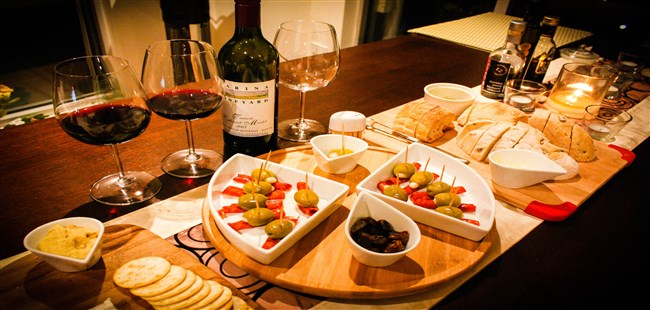A dinner party is an excuse to show off cooking skills that you may not necessarily use in everyday cooking. Plan carefully, and prepare as much as possible in advance so that you are able to enjoy time with your guests.
Presenting Food
Good presentation of food needs only basic decorating skills and simple but effective garnishes. Elaborate presentation of food can be reserved for formal occasions, but always make sure that the way in which the food appears enhances rather than overshadows your cooking.
Molding Vegetables
Cut vegetables, place a round pastry cutter on each plate, and spoon in the cooked vegetables, packing them firmly. Lift off the cutter, leaving the vegetables molded to shape.
Arranging Food
• Adding height Pile stir-fried dishes high in the center of a plate so that the helping looks attractive and generous.
• Fanning slices To arrange sliced food decoratively, such as an avocado or a chicken breast, slice the food, and lift it whole onto a plate with a spatula. Then fan out the slices evenly.
• Tieing bundles Use a chive “ribbon,” or thin strips of green leek blanched for 30 seconds, to tie vegetable sticks or baby vegetables together in small bundles.
Shaping Chocolate
Serving Creams And Sauces & Making Chocolate Baskets
Spread melted chocolate evenly over 7-in (18-cm) circles of waxed paper to within 1 in (2.5cm) of the edges. Mold over upside-down cups, let set, and peel off the paper. Use for serving desserts.
Making shapes Spoon a little sauce into a small piping bag, and pipe the outline of the shape you want on a plate. Carefully spoon the rest of the sauce lo fill in the shape. Setting purees Dissolve 1 t.sp (5 ml) gelatin in every 1 cup (250 ml) hot fruit puree, then pour the puree while still hot onto a serving plate. Chill the puree until set, then arrange the dessert however you wish.
• Creating a marbled effect Marble dark and while chocolatc sauces by stirring them together very lightly immediately before serving,
• Enhancing gravy Sprinkle fine strips of citrus zest, such as lemon or lime, into plain gravy to accompany grilled meat.
• Feathering cream flood a plate with chocolate sauce or fruit purée, then carefully spoon drops of heavy cream onto it at regular intervals. Draw the tip of a toothpick through each drop to make a chain of feathered heart shapes.
Designing A Pattern
Serve two sauces of similar consistency but contrasting colors together to create an impact. Create a simple but effective pattern by swirling one around the other, for example, on each side of a plate.
Adding Finishing Touches
Garnishes add an attractive finishing touch to a dish, particularly if you are cooking for a special occasion. Remember, however, that it is the dish that is important garnishes should complement, not compete with, the ingredients. Prepare elaborate garnishes in advance.
Enhancing Garnishes
• Shaping with a canelle knife
• Before slicing a cucumber as a garnish, run a canelle knife or the prongs of a fork down its sides at intervals. The slices will then have a fluted edge.
• Dipping in parsley Add color to lemon, or tomato wedges by dipping their edges into finely chopped parsley after cutting. Alternatively, dip the edges of tomatoes into finely grated Parmesan cheese.
• Deep-frying parsley To prevent parsley sprigs from becoming limp, deep-fry them first in hot oil until they are bright green and crisp. Drain on a piece of paper towel.
Garnishing With Fruits
Preparing strawberry fans To decorate summer desserts, leave the leafy tops on fresh strawberries, and use a sharp knife to cut thin slices through the fruits, leaving the slices attached at the stem end. Hold each stem, and lightly press the slices into a fan shape.
Cutting apple leaves: Cut a series of long, V-shaped notches in the side of an apple, each notch slightly bigger than the one before. Remove the pieces from the apple, and push each piece along on top of the one below to form a leaf shape.
Preparing Vegetable Garnishes
Making carrot hearts: For a romantic dinner garnish, shape a peeled carrot by cutting a groove down one side. Cut the opposite side to a point, so that cross-sections form heart shapes. Slice for individual hearts.
Garnishing Quickly
• Using trimmed leaves Keep the central leaves from a head of celery, and scatter them over savory dishes to add color.
• Scattering nuts Keep toasted, flaked almonds in a jar for scattering over hot and cold savory or sweet dishes as an instant garnish,
• Sprinkling sugar As a quick, effective topping for hot or cold desserts, shake sifted confectioners’ sugar lightly over the surface of the dish.
• Using zest Make a last- minute garnish for savory and sweet dishes by using a zester to grate fine strips of zest from citrus fruits. Scatter the zest over the food before serving.
• Grating coconut Use a vegetable peeler to grate curls of fresh coconut over main courses or desserts. Remove the flesh from the shell, but retain the brown skin. Grate across the skin and the flesh to keep the skin on the curls.
Making Scallion Tassels
Trim scallions, and cut short lengths from the leaf ends. Cut slits lengthwise, extending halfway along each piece from the leaf end. Place in iced water until the sliced Leaf ends curl.
Saving Time
Preparing ahead When entertaining, make garnishes such as lemon twists, scallion tassels, and tomato wedges in advance. Place on a plate, and add to the food at a later stage. Cover them with plastic wrap, and they will stay fresh for up to four hours.
Edible Flowers
The following flowers are edible, and are therefore good for decorative purposes. The large flowers of some vegetables, such as zucchini, and the flowers of some herbs are also edible. If you cannot identify a flower, do not eat it.
Apple blossom, Borage, Calendula, Clover, Dandelion, Daylily
El der flower Geranium; Lavender, Marigold, Nasturtium,
Orange,Pansy, Primrose, Rose, Violet
Serving Wine
Alcoholic drinks stimulate the appetite and enhance the flavor of food, so they can add to the enjoyment of any meal, however simple the food or the setting. If you are unsure about choosing wines, consult a good wine merchant, who will let you taste a selection before you buy.
Matching Wine With Food
There are no strict rules about which wine to serve with which dish, but the following guidelines are useful.
Order of drinking White wine is generally preferred before red, young before mature, and dry before sweet.
• Appetizers or canapés Serve crisp white wines, sparkling wines, or dry sherry.
• Fish dishes Serve diy white wines such as Mus cadet, or young, light reds.
• Pasta and cheese dishes Serve robust wines such as Rardolino (red).
• Creamy dishes Choose slighily acidic wines such as Sauvignon Blanc (white)
Preparing Wine
• Chilling wines To chill white wines, refrigerate for a maximum of two hours, or bury the bottles in crushed ice for 30 minutes before serving.
• Accelerating chilling Put wine in the freezer to cool quickly, leaving only for about five minutes. Set a timer so that you remember to remove it.
• Loosening wires To save time, loosen the wires of champagne corks while the bottles are chilling so that the corks are ready to pop.
• Warming red wines Pour red wine into a slightly warm decanter to warm quickly, instead of heating the wine directly. Uncork young red wine about an hour before serving to develop the flavor.
Traditional Tip
Decanting wine: Decant bottle-aged wine or port to remove sediment. To do this easily, insert an unbleached coffee filter into the neck of a glass pitcher, and pour the wine gently into it.
Serving Nonalcoholic Drinks
Whatever the occasion, offer your guests a selection of nonalcoholic drinks. Always have mineral water available for both drinkers and no nd tinkers, as well as fruit juices and cordials. Some people may prefer wine “lookalikes” such as grape juice or alcohol-free wines.
Adding Flavor
Stimulating the appetite Add a thin slice of fresh lemon or lime to each glass of mineral water to sharpen the appetite.
Accompanying spicy food Serve a refreshing, lassi-style yogurt drink with spicy food, such as an Indian curry, instead of wine or beer. Place cup (250 ml) plain yogurt in a blender with 2 cups (500 ml) water, XA tsp (2.5 ml) salt, and a sprig of fresh mint. Blend until smooth, then serve in tall, chilled glasses.
Adding celery sticks Use a small, trimmed piece of celery as a swizzle stick for stirring tomato or vegetable juice.
Making Milk Shakes
Using a screw-top jar: If you do not have a blender with which to make a milk shake, mix fruit purée and ice cream with milk in a large screw-top jar and shake. Alternatively, beat the mixture with a balloon whisk.
Alcohol-Free Cocktails
• Cranberry spritzer Stir equal parts cninberiy juice, white grape juice, and sparkling mineral water.
• Raspberry mint fizz Pour /4 cup (50 ml) raspberry syrup into a tall glass. Add a handful of crushed mint leaves and ice. Top off with soda water.
• Shirley Temple Shake several dashes of grenadine into a glass. Top off with lemon-lime soda for a bubbly froth. Finish with a maraschino cherry.
• Peppermint cream Shake peppermint cordial with cream and a little crushed ice.






